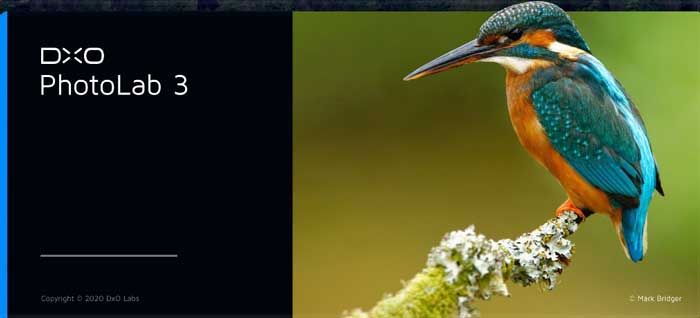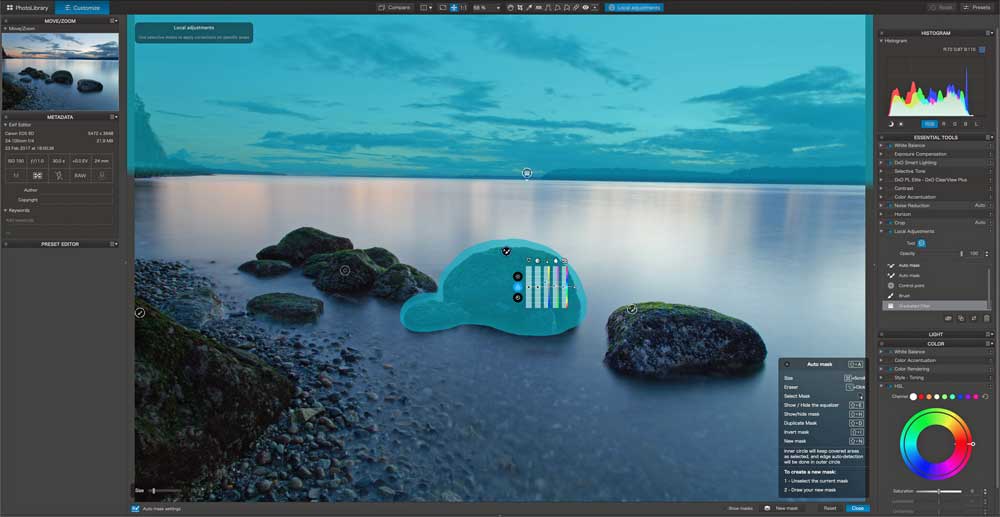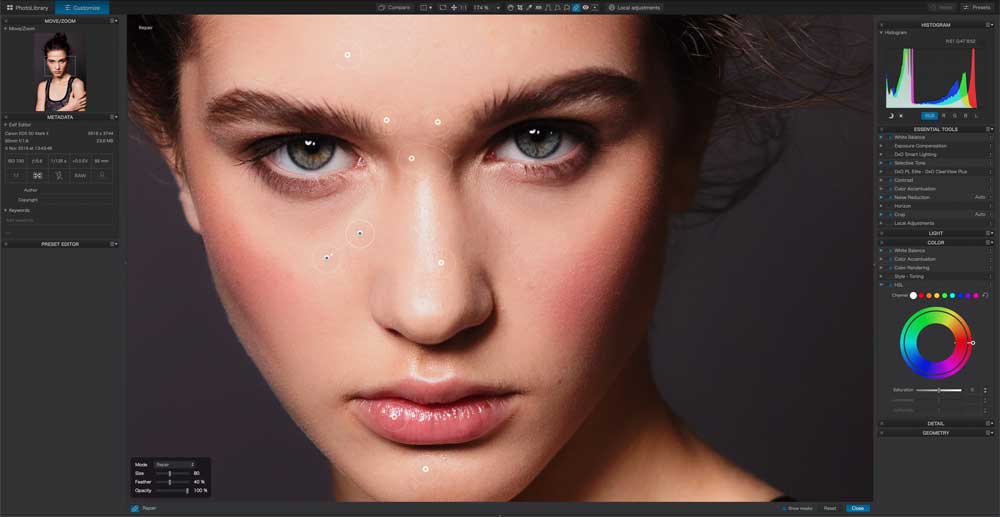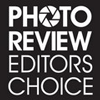DxO PHOTOLAB 3.2: A powerful raw file converter with wide-ranging and non-destructive editing functions, including class-leading de-noising and haze-reduction tools from the Nik Collection of specialised plug-in tools. DxO PhotoLab provides the most refined set of tools for editing raw files we’ve encountered. The inclusion of Nik-based U Point technology and PRIME denoising (RAW) plus DxO’s own ClearView Plus, Smart Lighting and Lens Sharpness functions creates a unique tool set for both global and local adjustments that is more powerful and capable than you’ll find in many higher-priced image editors.
RRP: Essential edition – US$129; Elite edition – US$199; upgrades from $69
 Developed by French company, DxO Labs, DxO PhotoLab is best thought of as a raw file converter with a versatile non-destructive editing tool set. It can only be used for editing still images and recognises raw files from most cameras past or current – except those from Fujifilm’s cameras with X-Trans filtration (which many raw processors can’t handle). When a file is dropped onto the workspace, performance data from more than 18 years of camera and lens testing is used to apply seamless corrections automatically. These corrections are often all the adjustments required.
Developed by French company, DxO Labs, DxO PhotoLab is best thought of as a raw file converter with a versatile non-destructive editing tool set. It can only be used for editing still images and recognises raw files from most cameras past or current – except those from Fujifilm’s cameras with X-Trans filtration (which many raw processors can’t handle). When a file is dropped onto the workspace, performance data from more than 18 years of camera and lens testing is used to apply seamless corrections automatically. These corrections are often all the adjustments required.

DxO PhotoLab comes in two versions: Essential and Elite. It can be downloaded free of charge and used for 30 days without limitations and, once purchased, the program is yours forever. The tools available are intuitive and functional and raw file processing is seamlessly integrated into the workflow.
Both versions benefit from the inclusion of U-point technology, acquired by DxO Labs when it acquired the powerful Nik Collection of image editing plug-ins. The Elite version includes four proprietary tools: DxO PRIME for noise reduction; DxO ClearView Plus for haze removal; DxO Smart Lighting for automatic exposure optimisation; and U Point local adjustment technology. The Essential version doesn’t include DxO PRIME or DxO ClearView Plus.
A few features some photographers might see as ‘essential’ are not included. Layers are not supported. File management facilities are limited, although DxO PhotoLab does offer some keyword management for image searching. However, while you can search by date and focal length as well as f-stop and ISO value, you can’t search by camera or lens name. There’s no Levels adjustment and the histogram can’t be used to make tonal adjustments. There’s no History panel so if you need to review what you’ve done, the Reset function will step you back through edits. But it’s not as good as having a simple overview of past edits. The only face detection function is via the Smart Lighting tool, which is limited. Geotagging is not supported and sharing to social media is limited to Flickr, which means you can’t email images directly from the program.
DxO PhotoLab’s greatest strength is as a raw file editor/converter, where it has few equals. Once up and running it’s quick to use and you can view edits as you make them. The combination of ClearView Plus and sharpening and microcontrast adjustments enables users to produce really sharp images with minimal risk of artefacts. Noise reduction through the denoising function is easy and very effective and the Colour Wheel is fun to use with multiple applications, both functional and creative. The software also ‘plays nicely’ with complementary applications like Lightroom.

Purchasing Points:
1. A one-off payment of around $300 gets you the premium version of DxO PhotoLab 3.2, one of the most powerful raw file processor/editors available, for less than a year’s subscription to the Adobe photography plan with 1TB of cloud storage.
2. The software is available for Windows and Mac OS platforms and supports ICC profiles for colour management as well as the newer DCP colour profiles.
3. The latest version of the software adds support for the Canon EOS-1D X Mark III, Leica D-Lux 7 and Q2, Nikon D780 and Olympus E-M1 Mark III cameras.
4. DxO’s optical modules, used to apply automatic corrections when images are uploaded, are based upon more than 18 years of expertise in camera and lens testing. The corrections, which include camera and lens-profile based geometry corrections for barrel, fisheye, and pincushion distortion, and DxO Smart Lighting for automatic exposure optimisation, may be all that’s needed for many images.
5. The inclusion of U-Point technology (acquired with the Nik collection in 2017) provides a powerful tool that can be used with adjustable brushes for local area brightness, contrast and colour adjustments as well as Graduated Filter, Mask, Eraser, Auto-mask, and Control Point tools. The Control Point tool, applies the same correction to all pixels in the selected area of the same colour and brightness value as the point, with feathering at the edges.
6. Other Nik-based plug-ins that can be accessed directly from DxO Photolab include DxO PRIME for noise reduction and DxO ClearView Plus for haze removal.
7. A new HSL adjustment colour wheel makes it easy to apply subtle changes to a selected colour range. An adjacent Uniformity slider allows the strength of the adjustments to be fine-tuned.
8. The customisable workspace has two modes: PhotoLibrary for browsing, uploading and organising image files and Customise, which contains the editing tools. These tools are grouped under the following titles: Histogram, Essential Tools, Light, Colour, Detail, Geometry and DxO ViewPoint. They can be arranged in any order, opened or collapsed with a mouse click or brought onto the working area for greater editing control and precision.
9. Editing is non-destructive and edits are saved in sidecar files that are kept in the same folder as the images. This saves space when different versions of images are stored.
10. Split-screen views are available for before and after comparisons during editing and the Help button accesses an extensive suite of instructions on using all aspects of the program.
Distributor: DxO Labs; https://www.dxo.com/dxo-photolab/
 Interest piqued? For a more comprehensive review of the ‘most refined set of tools for editing raw files’ click here.
Interest piqued? For a more comprehensive review of the ‘most refined set of tools for editing raw files’ click here.
– Or to go to our review of another worthy Adobe competitor, Serif Photo 1.8, click here.





Be First to Comment